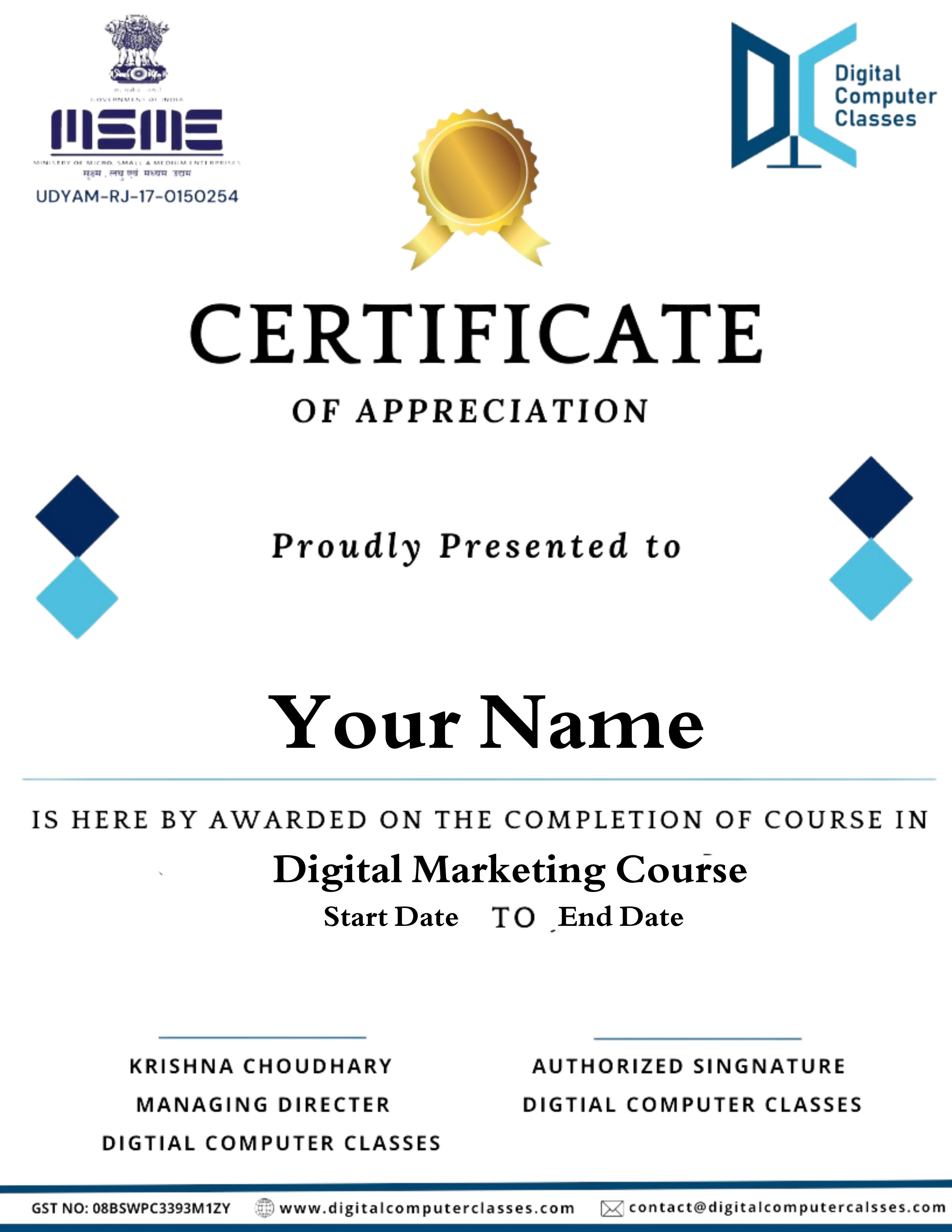

Learn > Implement > Practice
2hrs/day, 5Day/weekLearn > Implement > Practice
10th September 2025, 6pm-8pm
Become a professional marketerJoin Our Digital Marketing Course

Website planning and analysis is the first step in the whole process of web development which determines its future success. This stage can take a lot of time because it requires wide research, correct planning, and analysis of all the variants to meet both the business goals and needs of website visitors. Website planning involves identifying appropriate aims and objectives of the business that would require the construction of the ‘website’; the common goals may include raising brand recognition, lead generation, or better customer experience. To successfully design a user-first website, it is crucial to properly define a target audience through the use of archetypical characters or personas, as well as identification of the users’ journey through a website.
Other than laying down goals, a detailed analysis of competitors’ websites offers much-needed information on aspects such as where the industry is, what is achievable, and where the business stands in relation to competitors. Structuring the website layout, content and links means that there is a rational and easy-to-understand sequence. Preceding this, the site and mobile views are optimized in terms of the layout, and other requirements like, responsiveness, SEO optimization, and page load speed are also addressed to improve performance and functionality.
Carrying out a content audit and recognizing the holes would assist businesses in abiding by their content consumers’ expectations and search engines. Finally, evolved design and features are resulted from usability testing and feedback. Conclusively, a systematic approach to website planning and analysis provides a framework that is followed when implementing a website, thus enabling the brand message to get across, have relevance to the users, and encompass the business agenda.
Explore our comprehensive digital marketing modules. We cover 100+ modules, 50+ marketing tools, and 8+ digital marketing certificates! Our course is designed to help you learn the skills you need for a successful career in digital marketing.

Get a certificate of completion after successfully completing the course.
At Kevin Technocrats, we provide top-tier Digital Marketing training in Jaipur with AI tools. Our hands-on approach and strong focus on practical learning ensure a deep understanding of concepts. With a supportive classroom environment and a robust learning ecosystem, we empower even beginners to build confidence and excel. Over 3500 students have successfully launched their careers in digital marketing after joining our institute
Learn from highly experienced trainer with years of expertise in the field.
We offer 100% placement support to help you find a job in the digital marketing field.
We offer flexible batch timing to fit your schedule.
Learn digital marketing in modern classrooms, making the learning experience engaging and enjoyable.
We offer the opportunity to clear all your doubts with the trainer after each session, along with a dedicated doubt-solving session every week.
We provide practical experience with industry tools to help enhance your skills.
Web development is a very important skill in today’s digital world. It helps businesses create websites that are easy to use, look great, and work well on different devices. A good website allows companies to attract customers, build trust, and grow online. As more businesses move to the internet, the need for skilled web developers is growing fast. Whether you want to start a career in web development, become a full-stack developer, or create your website, learning web design and development is the key to success.
A web development course teaches you how to build and design websites from scratch. You will learn both front-end development, which focuses on the look and feel of a website, and back-end development, which deals with how the website works behind the scenes. If you choose full-stack web development, you will learn both front-end and back-end skills, making you a complete web developer. The best way to gain hands-on experience is by working on real web development projects, where you practically apply what you learn.
If you want a step-by-step learning approach, joining a top web development course is the best way to gain the right skills. Our best web development course in Jaipur covers all the important topics, including HTML, CSS, JavaScript, Python, Java, and frameworks like React, Angular, and Node.js. With expert trainers and an easy-to-follow curriculum, you can become a front-end developer, back-end developer, or full-stack developer.
If you are looking for web development courses in Jaipur, our institute offers one of the best web development courses with experienced trainers and hands-on projects. Whether you are a beginner or want to improve your skills, our course covers everything you need to become a skilled web developer. You will learn web programming, front-end development, back-end development, and full-stack development to build modern and professional websites.
We offer specialized courses to match different learning goals, including:
With our expert guidance and hands-on learning, you will gain real experience and confidence to build websites from scratch. Join our web development course in Jaipur today and take the first step toward a successful career in web development!
Our web development course covers everything you need to become a professional web developer. Whether you want to focus on front-end, back-end, or full-stack development, this course will equip you with the right skills. Below are the key topics included in our web development full course:
Many students often ask, “What is a web development course, and how much does it cost?” The cost of a web development course depends on various factors such as the institute, course level, duration, and whether it includes hands-on projects and certifications. Our web design and development course offers high-quality training at an affordable cost with flexible payment options, ensuring that everyone can learn without financial stress.
If you are looking for web development courses near you that provide the best value for money, our institute is the perfect choice. We focus on practical learning with real-world web development projects to help students build strong technical skills. Whether you are a beginner or want to specialize in full-stack development, we have different course options to match your learning goals.
The time required to complete a website development course varies depending on the level of expertise you want to achieve. Here’s an overview of different course durations:
The web development course fees depend on the type of course you choose. Short-term courses have lower fees, while full-stack development courses and advanced certification programs may cost more due to their extensive curriculum. Our institute provides budget-friendly web designing course fees along with flexible instalment options.
If you are searching for web development courses with certificates, our training program provides industry-recognized certifications to help you build a strong resume and increase job opportunities.
Whether you want to start a new career in website development, become a full-stack developer, or grow your skills with advanced training, our institute has the right course for you. Join us today and take the first step toward a successful career in web development!
A web development course with certificates can open doors to numerous career opportunities in the ever-growing tech industry. As businesses continue to expand their online presence, the demand for skilled web developers is higher than ever. Whether you specialize in front-end development, back-end programming, or full-stack development, completing a web development course can help you secure a stable and well-paying job in the IT industry.
If you are passionate about website development and want to build a successful career, enrolling in a full-stack web development course is a great choice. Web developers work in various industries, including e-commerce, digital marketing, software development, and IT services. Many companies are actively looking for talented professionals with hands-on experience in web development projects.
After completing a website development course, you can apply for different job roles based on your skills and interests. Some of the most in-demand web development careers include:
By enrolling in one of the best web development courses, you can develop the skills needed to succeed in this field. Whether you are searching for web development courses in Jaipur, online training programs, or full-stack development courses, the right education will help you build a successful and rewarding career.
Start your journey today and become a professional web developer with endless job opportunities waiting for you!
If you want to learn web development and build a successful career, our web development course is the perfect choice. Whether you are new to coding or want to improve your skills, our full-stack web development course will help you gain the knowledge needed to create websites and web applications.
Our trainers are experienced web developers who have worked on real projects. They will teach you step by step, making learning easy and practical. You will understand how to design and develop websites using the latest tools and technologies.
The best way to learn is by doing. That’s why our web development course includes real-world projects. You will practice building websites and web applications, which will help you develop strong skills. These projects will also be helpful when applying for jobs.
Our course offers both online and offline classes, so you can choose the best way to learn. Whether you are a student, a working professional, or someone switching careers, you can study at your convenience.
We provide high-quality training at a reasonable cost. Our web development course fees are affordable, and we offer flexible payment options. This ensures that anyone interested in website development can join without worrying about the cost.
After finishing the web development course, you will receive a certificate that proves your skills. This certification will make it easier to get a job in the web development industry.
We help students find good job opportunities after completing the course. You can work in roles such as:
✔ Simple and easy-to-understand lessons
✔ Training on the latest web technologies
✔ Live project experience
✔ Affordable course fees
✔ Job assistance to help you start your career
If you are looking for web development courses in Jaipur or want to learn full-stack development, this course is a great choice. Join us today and become a skilled web developer with great job opportunities!
Web development is a great skill that can help you build a strong career. Whether you want to become a full-stack developer, front-end developer, or web designer, learning web design and development will open many job opportunities. Businesses need websites to grow, and skilled web developers are in high demand.
Our web development course teaches both front-end and back-end development through real-world projects. You will learn important programming languages like HTML, CSS, JavaScript, Python, and Java to create professional websites. Whether you are interested in website development, UI/UX design, or full-stack development, this course will give you all the skills you need.
We offer affordable web development course fees and flexible learning options so you can study without stress. You can choose a short-term course or a full-stack developer course with an industry-recognized certificate. We also provide placement assistance to help you get jobs as a web developer, front-end developer, or full-stack developer.
By joining our web development course in Jaipur, you will gain all the knowledge needed to start a successful career. Whether you want a high-paying job, freelance projects, or your own web development business, this course will help you achieve your goals. Now is the best time to start learning web design and development. Take the first step toward your future today!
Website planning is the initial stage of website development. It involves gathering ideas to define the website's purpose, visual design, functional features, and budget for its creation and maintenance.
Prepare for site mapping. Brainstorm content types. Decide on the main navigation. Establish secondary and tertiary hierarchy. Plan utility pages. Note page details and specifications. Choose page templates. Revise and refine your plan.
Site planning is crucial because it strategically organizes landscapes and structures to enhance functionality and beauty. It ensures compliance with legal and environmental standards while optimizing how people interact with their surroundings.
